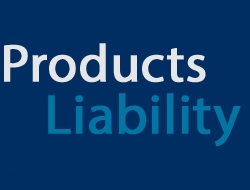

Pennsylvania Supreme Court's Decision in Tincher v. Omega Flex, Inc. Leaves the State of Products Liability Litigation Up in the Air
 The Pennsylvania Supreme Court granted allowance of appeal in the case of Tincher v. Omega Flex, Inc. to address whether Pennsylvania would adopt the framework set forth in the Restatement (Third) of Torts with respect to strict products liability cases. In its highly anticipated Opinion, published 13 months after oral argument, a divided Supreme Court, by a vote of 4-2, ultimately declined to “adopt” the Restatement (Third) of Torts framework. See Tincher v. Omega Flex, Inc., 2014 Pa. LEXIS 3031 (Pa. Nov. 19, 2014). However, the Court’s opinion went beyond that limited question, substantially redefining the contours of strict liability design defect claims in Pennsylvania, while at the same time leaving development of the new standard to be determined on a case-by-case basis by future court decisions.
The Pennsylvania Supreme Court granted allowance of appeal in the case of Tincher v. Omega Flex, Inc. to address whether Pennsylvania would adopt the framework set forth in the Restatement (Third) of Torts with respect to strict products liability cases. In its highly anticipated Opinion, published 13 months after oral argument, a divided Supreme Court, by a vote of 4-2, ultimately declined to “adopt” the Restatement (Third) of Torts framework. See Tincher v. Omega Flex, Inc., 2014 Pa. LEXIS 3031 (Pa. Nov. 19, 2014). However, the Court’s opinion went beyond that limited question, substantially redefining the contours of strict liability design defect claims in Pennsylvania, while at the same time leaving development of the new standard to be determined on a case-by-case basis by future court decisions.
The centerpiece of the Opinion is the unanimous decision by all justices to overrule the 1978 case of Azzarello v. Black Brothers Co. Ever since the Supreme Court’s ruling in Azzarello, Pennsylvania adhered to the principle that negligence concepts have no place in “strict” products liability claims. As a result, courts disallowed evidence and defenses that incorporated negligence concepts from being presented for the consideration of juries.This resulted in courts barring comparative negligence defenses, evidence of compliance with industry standards, and evidence of reasonable conduct on the part of the manufacturer-supplier. The Azzarello decision, and its progeny, directed judges to initially consider whether a product was unreasonably dangerous by weighing foreseeable risks and product utility in the light most favorable to the plaintiff. Thereafter, if a product could be considered “unreasonably dangerous,” the jury was to determine if a product was defective because it “lacked any element necessary to make the product safe” with the product manufacturer/supplier being the “guarantor” of the safety of its product.
The Supreme Court expressly overruled Azzarello, and its reasoning, finding that the strict liability vs. negligence dichotomy it created was unworkable and did not accurately reflect Pennsylvania “common law” concerning liability for injuries caused by products.Thus, the opinion found that foreseeable risks and product utility are matters appropriate for juries to consider. The Court found that the Restatement (Third) of Torts approach, although it expressly permits consideration of foreseeable risks and reasonableness of product design decisions, also does not represent the law in Pennsylvania. Rather, the Court found that the Restatement (Second) of Torts still provides a workable standard that meets the goals of Pennsylvania tort law with respect to products cases, albeit without the strict prohibition of consideration of negligence concepts mandated by Azzarello.
The Court further announced a new standard for determining whether a product is “defective” under the Restatement (Second) of Torts in design defect cases. That new standard requires a plaintiff to show a product is defective by demonstrating:
either that (1) the danger [causing the plaintiff’s harm was] unknowable and unacceptable to the average or ordinary consumer, or that (2) a reasonable person would conclude that the probability and seriousness of harm caused by the product outweigh the burden or costs of taking precautions.
Id. at * 2. This allows a plaintiff to pursue a products liability claim under a “consumer expectations" or "risk-utility" theory, or both. The question of whether a product is defective under either theory is to be made by a jury, unless no reasonable jury could find a defect. The Court did away with the initial risk-utility balancing analysis performed by judges under Azzarello.
As negligence concepts, such as foreseeability, are now apparently permissible considerations for a jury in “strict” products liability cases, the Tincher decision raises numerous questions that the Supreme Court declined to answer. For example, the Court did not decide what evidentiary factors may prove that an average or ordinary consumer would find the danger of a product was unknowable and unacceptable. The Court set forth factors that have been used in risk-utility balancing, but declined to adopt those factors. The Court declined to decide whether evidence of industry standards would become admissible, whether a defendant can assert negligence-based defenses, or whether evidence of reasonable conduct on the part of the manufacturer would be admissible. The Court also declined to decide whether bystanders who were not users of the product at issue could recover under the new standard. As stated by the majority opinion, “[t]his Opinion does not purport to either approve or disapprove prior decisional law, or available alternatives suggested by commentators or the Restatements, relating to foundational or subsidiary considerations and consequences of our explicit holdings.”
The Court even declined to create a “bright-line rule” regarding how a jury should be guided with respect to these new standards, instead finding that courts and attorneys should offer instructions applicable to the circumstances of each case:
the test we articulate today is not intended as a rigid formula to be offered to the jury in all situations. The alternate theories of proof contour the notion of "defective condition" in principled terms intended as comprehensive guidelines that are sufficiently malleable to account for product diversity and a variety of legal claims, products, and applications of theory.
Id. at * 212-13. Stating, also:
it is incumbent upon the parties, through their attorneys, to aid courts in narrowing issues and formulating appropriate instructions to guide juries in their factual determinations. . . . It is worth reiterating that “[b]right lines and broad rules always offer a superficially enticing option.”
Id. at *206-07. So what does this all mean in practice? It means that until the standard enunciated by the court in design defect cases is developed through further court decisions, specific evidentiary and legal standards in products liability cases are up for debate. One local prominent plaintiff’s attorney has already been quoted as saying “It’s going to be the wild, wild west where you’re going to make the law as you go.” Comparative negligence will be pleaded as an affirmative defense. Evidence of compliance with industry standards should be gathered in each case. Defendants should continue to develop cases with an eye towards establishing reasonable conduct in designing products. Parties should consider such factors as product risks and benefits. Alternative designs should be considered. Consumer expectations must be analyzed and developed. Each of these areas is now undetermined and will only be determined on a case by case basis until the debate regarding these issues is settled. It will be the overarching principles announced in Tincher that will provide the backdrop and frame for that debate in each case – and an uncertain future.
For more information about the impact of the Tincher decision and/or products liability law, contact Post & Schell Casualty Litigation Chair Daniel S. Altschuler at daltschuler@postschell.com, Principal Richard B. Wickersham, Jr. at rwickersham@postschell.com, or Associate J. Colin Schwartz at cschwartz@postschell.com.
Disclaimer: this E-Flash does not offer specific legal advice, nor does it create an attorney-client relationship. You should not reach any legal conclusions based on the information contained in this E-Flash without first seeking the advice of counsel.


